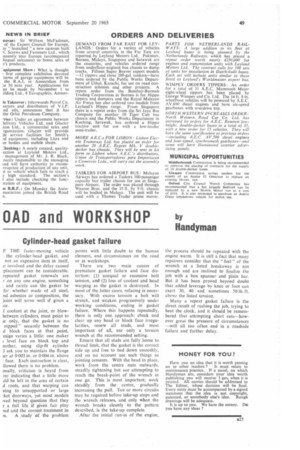OAD and WORKSHOP by
Page 51

If you've noticed an error in this article please click here to report it so we can fix it.
Handyman Cylinder-head gasket failure
F THE faster-moving vehicle the cylinder-head gasket, and not an expensive item in itself, ir involved and the delay caused :placement can be considerable. repeated gasket renewals are r on any one engine, something and rarely can the gasket be for whether made of all steel, rid asbestos or composition, the joint will serve well if given a
ice.
f coolant at the joint, or blowbetween cylinders, must point to ;e only, that the gasket is no nipped" securely between the d block faces at that point. esign varies a little: one maker : level face on block top and nother, using slip-fit cylinder LI ask you to maintain the flange ler at 0.003 in. or 0-004 in. above face. Each instruction is clear, flowed there is no problem. anally, criticism is heard from rer indicating that a little more ald be left in the area of certain d roots, and that warping can sting to unsupported or large :ket doorways, yet most models wed beyond question that they it a full life if given fair play rad arid the correct treatment in ss. A study of the problem
points with little doubt to the human element, and circumstances on the road or in workshops.
There are two main causes of premature gasket failure and face distortion: (1) unequal or excessive bolt tension, and (2) loss of coolant and head warping as the gasket is destroyed. In most of the latter cases, refacing is necessary. With excess tension a bolt will stretch, and weaken progressively under working conditions, ending in gasket failure. Where this happens repeatedly, there is only one approach: check and clear up any head or block face irregularities, renew all studs, and most important of all, use only a torsion wrench at the recommended setting.
Ensure that all studs are fully home to thread limit, that the gasket is the correct side up and free to bed down smoothly, and on no account use such things as jointing cements. With the head in place, work from the centre nuts outwards, steadily tightening but not attempting to reach the break-point of the wrench in one go. This is most important; work steadily from the centre, gradually increasing the pull. Ten or more circuits may be required before take-up stops and the wrench releases, and only when the wrench breaks cleanly to the pattern described, is the take-up complete.
After the initial run-in of the engine,
the process should be repeated with the engine warm. It is still a fact that many repairers consider that the " feel " of the wrench at a listed breakaway is not enough and are inclined to finalize the job with a box spanner and plain bar. But it has been proved beyond doubt that added leverage by knee or foot can exert 30, 40 and sometimes 50 lb. ft. above the listed tension.
Many a repeat gasket failure is the direct result of rushing the job, trying to beat the clock, and it should be remembered that attempting short cuts—however great the pressure of circumstances —will all too often end in a roadside failure and further delay.




















































































































